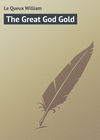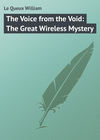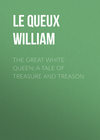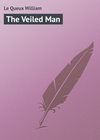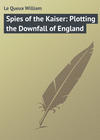Loe raamatut: «The Great God Gold», lehekülg 5
Chapter Ten
Fact or Fiction
“I may perhaps with advantage give you very roughly some historical facts which tend to negative Diamond’s theory,” the Professor said, turning to Farquhar while Gwen was absent.
“That is what I’m most desirous of hearing,” replied the young man. “I can claim no special knowledge like yourself. Indeed, no man in England is more capable of expressing an opinion than you are.”
The Professor passed his hand through his scanty grey hair and smiled. He saw that his wide knowledge impressed this young man whose only thought was a “sensation” in one or other of the Gavin group of publications.
Then, when Gwen had re-entered the room with a Bible in her hand, he said in that slow, deliberate habit of his, the habit of the scholar and deep thinker:
“The theory of this Doctor Diamond is that the treasures of Solomon’s temple were hidden by the priests prior to the taking of Jerusalem by Nebuchadnezzar. Well, that is a bold but quite unsubstantiated assertion. As early after Solomon as the reign of Jeroboam the First, King of Judah, the golden calves, the symbols of the Heliopolitan deity, were set up in the two extremities of the kingdom, and the temple was put to sacrilegious usages. These sins were continued by his successors, until in the reign of Asa, the third King of Judah, the impure orgies of Ashtoreth were suppressed, for ‘having his heart perfect with Jehovah all his days’ the king repaired Shishak’s plunder – the first plunder of the temple, mark you – with ‘rich offerings of gold and of silver.’ Asa made war against the Ethiopians, and on returning to Jerusalem the prophet Azariah, son of Oded, met him and exhorted him and his subjects to be strong heart in hand in seeking God. He gave an affecting description of the former state of Israel: ‘For a long season Israel hath been (or was) without the true God, and without a teaching’ priest, and without law. (2 Chronicles, xv, 3.) His words roused the hearers to a new and more thorough reformation. The idols were removed from all the cities of Judah and Benjamin, and those which had been won from Ephraim. The altar of burnt-offering, which had been polluted by Jeroboam, was renewed, and in the third month of the fifteenth year (B.C. 940) Asa called a great convocation at Jerusalem. Jehoshaphat followed his father’s piety, but the darkest night of Israel’s spiritual declension came with the accession of Ahab, seventh King of Israel, and husband of Jezebel. The service of Baal was established throughout Israel, a grove was made for the orgies of Ashtoreth, and by Jezebel’s orders the prophets of Jehovah were put to death, all except one hundred who were hidden in a cave by Obadiah, the governor of Ahab’s house.”
“But was the temple already plundered?” asked Gwen, seated with her chin resting upon her hand, listening intently.
“We know that it was plundered seriously by Shishak, King of Egypt, who carried off many of its greatest treasures, including the celebrated golden shields of Solomon’s house, which Rehoboam replaced by brass to keep up the display,” was the Professor’s prompt reply. “Recent discoveries at Karnak tell the whole story of the conquest from the Egyptian point of view. The kingdom of Judah, it seems, became for a long time tributary to Shishak, and upon the walls of the great temple at Karnak there are the sculptured representation of the siege and the hieroglyphics ‘Fuda Melchi’ – meaning ‘The Kingdom of Judah.’ That was, you will bear in mind, the first spoliation.”
“Were there others?” asked Frank. “I mean others that are authenticated by recent discoveries?”
“Yes, Jehoram reigned in Jerusalem from B.C. 895-892, and after his marriage with Athaliah, daughter of Ahab, the temple was again despoiled, and the daughters of Judah were once more prostituted to the rites of Ashtoreth,” replied Professor Griffin. “Joash, in B.C. 884, repaired the fabric of the temple by public subscription, for he was the inventor of the modern money-box – and there were enough funds left over, we are told, to purchase vessels for the sanctuary. (2 Kings, xii, 4-6; 2 Chronicles, xxiv, 4-14.) This, however, did not last long, for in the reign of Amaziah, ninth King of Judah, Jehoash, King of Israel, defeated him in B.C. 826, took him prisoner and, entering Jerusalem again, reached the temple and conveyed all its treasures to Samaria.
“In the reigns of Jeroboam the Second, Shallam, Menaham and Pekehiah, other vessels and treasures were provided for the temple. Jonathan built the high gate, but his successor, Ahaz, after plunging into all the idolatries of the surrounding nations, making molten images for Baal and sacrificing his children to Moloch in the valley of Hinnom, found himself, according to our best chronologer, Ussher, involved in war. He was therefore compelled to apply for help to Tiglath-pileser, the ‘Tiger-Lord of Asshur,’ King of Assyria, against Syria and Israel, and declaring himself his vassal, sent him all the treasures then left in the temple. Ahaz, we learn from 2 Kings, xvi, 10-18, profaned the temple by dismounting the brazen altar and replacing it by another. Likewise the ‘Great Sea of Solomon,’ too large to be removed at previous despoliations, was dismounted from its supporting oxen, and the lavers from their bases, which were also sent to the King of Assyria, together with the coverings which had been built for the King’s entry to the house, and for the shelter of the worshippers on the Sabbath. The golden vessels of the House of God were cut in pieces and sent with the rest, and the sanctuary itself was shut up. Hezekiah, who came after him in B.C. 726, reopened and restored the Holy Place, though it was now devoid of most of its treasures.
“To trace the history of the Temple through the days of Hoshea, son of Elah, Manasseh and Amon is perhaps unnecessary. Under Josiah, whose reign marks the last dying glory of the earthly kingdom of David, idolatry was put away, the Temple was renovated and the Ark of the Covenant which had been hidden restored to its place. (2 Chronicles, xxxiv, 3-13; xxxv, 3.) During these repairs the high priest Hilkiah found the sacred copy of the book of the law and delivered it to Shaphan, the scribe, who read it before the king. It was afterwards publicly read, and incited a new zeal among the people, and once again was the sanctuary filled with gold and silver vessels. Therefore you will see that by this period there could not have been any of the actual treasures placed by Solomon remaining in the Temple.”
“The Ark of the Covenant was still there,” remarked young Farquhar.
“That is not at all certain,” was the old man’s reply. “Many of the events chronicled in the Old Testament are corroborated by the inscriptions found by Flinders Petrie in Egypt and by Layard at Nineveh. Others are negatived, and our chronology rendered uncertain. Certain it is, however,” he went on, “that in the fourth year of the reign of Jehoiakim, eighteenth King of Judah (B.C. 608-597), Nebuchadnezzar arose, and a few years later advanced to Jerusalem, which he took after a brief siege. The vessels of the sanctuary were carried off to Babylon, where they were dedicated in the temple of Belus. If you turn to 2 Kings, xxiv, 13, you will there read: ‘And he carried out thence all the treasures of the house of the Lord, and the treasures of the king’s house, and cut in pieces all the vessels of gold which Solomon, King of Israel had made in the temple of the Lord, as the Lord had said.’”
“Surely it was Ezekiel who went as one of the prisoners of Nebuchadnezzar to Babylon,” remarked Gwen.
“Yes,” replied her father, “on the second occasion when the Babylonian king attacked the city. But,” he added, “in the reference I have just given you, you will note that the vessels are described as ‘those that Solomon had made.’ Either therefore they had been too massive for removal on the many previous occasions when the temple was plundered or they had been made to replace the ancient originals. The latter is my own theory. Now, as I dare say you will recollect, in B.C. 586, on the tenth day of the fifth month, Ab, Nebuchadnezzar again advanced against the rebellious city of Jerusalem and destroyed it. The two great pillars of the temple porch, Jachin and Boaz, and Solomon’s brazen sea with the twelve bulls supporting it, were broken in pieces and their brass transported to Babylon, together with a great number of captives. And on the third day of the catastrophe, in the nineteenth year of Nebuchadnezzar, the temple and the city were committed to the flames with the palaces of the king and princes, and all the chief houses of Jerusalem, and their walls levelled to the ground.”
“Then that was the actual end of Solomon’s temple,” remarked Frank Farquhar. “Is that authentic?”
“Without a doubt,” said the Professor. “Yet did not Jeremiah comfort the Jews amid all these judgments by contrasting His destruction of the other nations of their present oppressors with His correction of themselves? ‘Fear thou not, O Jacob, my servant, saith Jehovah, for I am with thee; for I will make a full end of all the nations whither I have driven thee; but I will not make a full end of thee, but correct thee in measure; yet will I not leave thee wholly unpunished.’ Surely no words could more fully express the principle of Jehovah’s dealings with the Jews, His own people, in every age.”
“Belshazzar, at his feast in Babylon, put to sacrilegious uses the vessels of the temple, did he not?” asked the young man.
“Yes,” answered Griffin, and addressing Gwen said: “Turn to the fifth chapter of Daniel, dear, and read out the first four verses.”
The girl found the place and read as follows: “Belshazzar, the King, made a great feast to a thousand of his lords, and drank wine before the thousand. Belshazzar, whiles he tasted the wine, commanded to bring the golden and silver vessels which his father Nebuchadnezzar had taken out of the temple which was in Jerusalem; that the King and his princes, his wives and his concubines, might drink therein. Then they brought the golden vessels that were taken out of the temple of the house of God which was at Jerusalem; and the King, and his princes, his wives, and his concubines, drank in them. They drank wine and praised the gods of gold, and of silver, of brass, of iron, of wood, and of stone.”
“And at that moment,” remarked the Professor, “was seen the prophetic handwriting on the wall: ‘Mene, mene, tekel, upharsin,’ being followed by the city’s surprise by Cyrus the Great, and its fall and destruction. Then under Cyrus, the Israelites returned from their captivity, and by his decree another temple was built by Zerubbabel, the prince of Judah, who was leader of the migration. Cyrus caused his treasurer Mithredath to deliver up the vessels which Nebuchadnezzar had carried away from Jerusalem, five thousand four hundred in number, to Zerubbabel to be re-consecrated to the service of Jehovah.”
“Is it to this second temple which our manuscript relates, do you think?” queried Frank. “Or is it to Solomon’s temple?”
“Of the temple of Zerubbabel we have but few particulars,” answered the Professor, “and no description that would enable us to realise its appearance. But there are some dimensions given in the Bible and elsewhere which are extremely interesting as affording points of comparison between it and the temple of Solomon and Herod after it. The first and most authentic are those given in the Book of Ezra (Ezra vi, 3-4) when quoting the decree of Cyrus, wherein it is said: ‘Let the house be builded, the place where they offered sacrifices, and let the foundations thereof be strongly laid; the height thereof three-score cubits, and the breadth thereof three-score cubits, with three rows of great stones and a row of new timber.’ Josephus quotes this passage almost literally, but in doing so enables us with certainty to translate the word here called ‘row’ as storey, as indeed the sense would lead us to infer – for it could apply only to the three storeys of chambers that surrounded Solomon’s, and afterwards Herod’s temple, and with this again we come to the wooden talar which surmounted the temple and formed a fourth storey. It may be remarked that this dimension of sixty cubits in height accords perfectly with the words which Josephus puts into the mouth of Herod when he makes him say that the temple built after the Captivity wanted sixty cubits of the height of that of Solomon. For as he had adopted the height of a hundred and twenty cubits in the Chronicles for that temple, this one remained only sixty. This temple was still standing in Herod’s time, and was repaired by him. Hecataeus mentions that the altar was twenty cubits square and ten high. But he unfortunately does not supply us with the dimensions of the temple itself. Therefore if the priests and Levites and Elders of families were disconsolate at seeing how much more sumptuous the old temple was than the one which on account of their poverty they had just been able to erect, (Ezra, iii, 12-13; Joseph Ast., xi, 4, 2) it certainly was not because it was smaller, as almost every dimension had been increased one-third; but it may have been that the carving and the gold and other ornaments of Solomon’s temple far surpassed this, and the pillars of the portico and the veils may all have been far more splendid, so also probably were the vessels; and all this is what a Jew would mourn over, far more than mere architectural splendour.”
“It is a pity we do not know more about this second temple,” remarked Gwen, in a tone of disappointment and regret.
“For our present purpose its history, down to the taking of Jerusalem by Titus, does not concern us, my dear,” remarked the old scholar, drawing his hand rather wearily over his white brow. “The problem before us evidently has to do with the days of Jehoiakim, prior to the advance of Nebuchadnezzar. Later facts and traditions do not concern us at the moment. I think, however, I have given you an outline of the varied history of the temple and its treasures based upon the very latest readings of Egyptian, Assyrian and other inscriptions, sufficient to show you quite plainly that Solomon’s treasure could not possibly have existed in the reign of Jehoiakim, and that the theory of this friend of yours, Diamond, is utterly and entirely without the foundation of tradition or of ancient legend.”
“Well,” remarked the young man, “such an opinion coming from your mouth is, of course, final, Professor. Yet you must admit that the statement, even as it stands, is full of interest.”
“Full of very cleverly conceived mystery – and mystery is always attractive,” laughed the Professor, looking at him through his big, round, highly magnifying spectacles.
In the statement he had made there was one discrepancy, one that only a scholar would notice. He had purposely withheld one Biblical reference – one which, above all, had caused him to reflect and believe that the writer of the half-burnt screed was correct, that the secret and its key were actually genuine.
But it was his fixed intention to turn Frank Farquhar from further investigation, and to laugh at Doctor Diamond as a fool, ignorant of any knowledge of the history of the Hebrew race.
A silence fell. Gwen Griffin and her lover were both staring straight at the fire without uttering a word.
The old man sat watching the effect of his words upon the pair, and before Frank left, he handed back to him the charred remnants which he had received from the photographer.
But his thoughts were of that other man – the short, white-bearded foreigner, his rival – who was so busy with his researches, the stranger from across the Channel who also held the remarkable secret.
Chapter Eleven
The Great God Gold
After dining at the club Frank Farquhar strolled round to Half Moon Street, and throwing himself into an armchair before the fire, gave himself up to reflection.
He was recalling what the Professor had said. It was true that all stories of lost treasure were nowadays received with incredulity, and surely this was the most amazing and most wonderful of them all.
Arminger Griffin, Regius Professor of Hebrew, treated the whole matter as a huge joke. Historical fact was wholly against the suggestion contained in these half-burned scraps which, before his departure from Pembridge Gardens, the Professor had handed back to him. Ah! if they could only reconstruct the context of those disjoined words.
He took a cigar and lit it. But a moment later he tossed it impatiently into the fire. It tasted bitter. The Professor had dashed all his hopes to the ground, for was not his opinion on such a matter final.
As he bade good-night to Gwen in the hall and held her soft hand in his she had whispered to him words of encouragement. “Father is really devoid of any romance,” she declared. “There may be something in the secret after all. Could you not endeavour to find the person who made that remarkable declaration?”
Her suggestion he was now carefully considering.
The stranger who had died in Paris was apparently not the person who made the declaration. The latter was in all probability alive. If so, could he not furnish many more facts than the scrappy information they at present possessed?
Yet what right had Doctor Diamond to the secret – and for the matter of that, what right had he himself?
That the hard-up stranger in Paris feared lest the documents should fall into other hands was shown by his last act of causing them to be burned. Such a course made it appear as though the stranger had no right to the possession of the papers. In all probability he had not!
Gwen’s suggestion, however, appealed to him. Yet to find that one man in the whole world who knew the truth would, he foresaw, be a work fraught with greatest difficulty. The only manner by which he could be approached, if found, would be upon pretence of restoring to him the charred remains of his valuable statement.
The telephone-bell rang, and he rose and answered it. The editor of one of the great daily journals controlled by his brother-in-law, Sir George, spoke from the office in Fleet Street, at that hour of the evening a hive of industry. A question of policy had arisen, and the editor, one of the shining lights of modern journalism, consulted Frank as representative of the proprietor, Sir George being still in Egypt.
Frank, after a brief conversation, left the matter entirely in the editor’s hands, and replacing the receiver walked back from the big roll-top writing-table to the fireplace, where he stood with both arms leaning on the mantelshelf gazing thoughtfully into the blazing coals.
A few moments later his man entered saying:
“A gentleman to see you, sir – Doctor Diamond.”
Frank started. His visitor was the very man of all men he wished most to consult, therefore he gave orders for him to be shown in at once.
“Why, my dear Doctor,” cried the young fellow, as the ugly little old man entered, “this is a real surprise! I thought of running down to Horsford to see you in the morning. Take off your coat and sit down. I want to have a serious chat with you.”
“I got no reply to my two letters, Mr Farquhar,” said the crook-backed little man in explanation of his visit. “So I thought I’d just run up and see how you are progressing with our business.”
Frank helped him off with his shabby frieze coat and, having installed him comfortably by the fire and given him a cigar, replied:
“Well, Doctor, the fact is I did not reply to your letters because I had nothing definite to report. I trust you will not attribute my silence to any want of courtesy. I have been busy over the matter ever since I returned to London.”
“And with what result?” asked the crafty-eyed little man.
“Nothing very satisfactory, I regret to say,” was the young man’s answer. “Yet I am not discouraged. Professor Griffin, before whom I have placed it, gives as his opinion that there is probably, something in the theory, but he will not quite commit himself to any absolute declaration.”
“Is he really competent to judge?” Diamond queried.
“Competent! Why, my dear sir, he’s one of the first Hebrew scholars in the world! He is daily engaged in making researches. History, as we are acquainted with it, may negative the theory advanced in those scraps of typewriting, yet Old Testament history is, as you know, very involved and often very contradictory.”
“Well,” exclaimed the Doctor, “to tell the truth, Mr Farquhar, I’m getting anxious. What I fear is that too many people will get knowledge of it. Then, with the secret out, we shall have others trying to investigate. And with such a gigantic business before us, is it any wonder that I’m becoming impatient?”
“Many a good business is spoilt by being in too great a hurry,” Frank declared. “Remain patient, and leave matters entirely to me,” he added reflectively. “I’ve been wondering whether, if we made diligent and secret inquiry, we might not discover the actual person, whoever he may be, who made the curious declaration. It certainly was not your dead friend.”
The Doctor hesitated. The idea at once commended itself to him.
“No,” he said. “Often when I have recalled all the romantic facts, I have been inclined to suspect that the man who died, although a scholar, had no right to possession of those papers. He intended to make money with them if death had not come so unexpectedly. His very words proved that.”
“Exactly my opinion,” declared Frank. “Now if we could but find out who the mysterious discoverer really is, we might approach him under pretence of handing back to him the remains of the papers.”
“Ah! You still have them safely, eh?” demanded the Doctor.
“Certainly. They are locked in from prying eyes in my desk yonder.”
“May I have them?”
“Of course,” was Frank’s unhesitating reply, though he had no desire to part with them at that juncture. Yet he had, unfortunately, no excuse for keeping them further. He could not say that the Professor held them, as he had given his visitor a solemn promise not to allow the documents out of his possession.
So he rose, unlocked a drawer with the key upon his chain, and handed to the deformed man the packet containing the half-burnt statement.
“Well,” remarked Diamond, as he took the precious documents in his hand, “if you think it a wise course, let us adopt it.”
“Yes, but where are we to commence our search?”
“The stranger said he was a Dane. He came from Copenhagen. Is it not probable,” suggested the Doctor, “that the discoverer was some friend of his residing in that city?”
“More than likely,” Farquhar agreed. “Yes. Let us try Copenhagen. We must first find out who are the professors of Hebrew resident there. I will write to our Copenhagen correspondent to-night and ask for a list. Then, if necessary, I will run over there myself. In this matter we must lay out a decisive line of inquiry and follow it up.”
“Quite so,” exclaimed the hunchback. “Copenhagen must be our starting-point. The initial difficulty, however, as far as I discern, is that we do not know our dead friend’s name. If we did and could trace him, we might discover whether he knew anybody who was a Hebrew scholar.”
“The Danish police would furnish us with names and descriptions of persons lately missing from the capital.”
“So they would, that’s a brilliant idea,” exclaimed the Doctor. “My opinion is that the reason why he refused his name to me, even at the final moment, was because he was wanted by the police, and intended that they should remain in ignorance of his end.”
“If so, it makes our inquiry far easier,” declared Frank. “And suppose we find him?” he asked.
“If we find him,” answered Diamond, looking straight into the eyes of the ambitious man opposite – “if we find him, we will compel him to furnish to us the context of the statement.”
“Compel – eh?” repeated the other, a hard smile playing about the young man’s lips. Diamond was a queer figure and strange persons had always attracted him. Through the ugly little doctor he had gained this remarkable knowledge of an uncanny secret withheld from the world for over two thousand years. He was reflecting what a “boom” the discovery would be for that great daily newspaper of which he was one of the Board of Directors.
“Then you agree that we shall at once turn our attention to Copenhagen – eh?” he asked.
“Certainly – the sooner the better.”
“We have no photograph of your friend – a most unfortunate fact.”
Diamond gave a detailed description of the dead man, and his friend, crossing to his writing-table, wrote it carefully at his dictation.
“I’ve been in Copenhagen several times,” Frank remarked, “so I know that city fairly well. I wonder whether the man we seek is a professor at the University?”
“Our first object is to establish the dead man’s identity.”
“He may have lied, and perhaps was not a Dane after all! He may have been a Norwegian, or even a Swede.”
Diamond raised his deformed shoulders and answered:
“True, as he was so bent upon concealing his identity he may well have lied to me regarding his nationality. Yet we must risk that, don’t you think?”
“But you told me that you were convinced that he was a Scandinavian.”
“Yes. But he might have come from Stockholm, or Gothenburg or Christiania.”
“Our first inquiries must be of the Danish police,” Frank said decisively. “I’ll write to-night to our correspondent in Copenhagen.”
“Would it not be best for you to go there and make inquiries yourself?”
“I may do that. Most probably I shall.”
“Stories of treasure are always attractive,” remarked the Doctor, casting a crafty glance at his young friend. “I hope, Mr Farquhar, you will make no mention in any of your papers regarding it.”
“My dear Doctor, don’t worry yourself about that,” Frank laughed. “Of treasure stories we’ve of late had a perfect glut. For a long time, for instance, I’ve taken a deep interest in the wrecks of vessels known to have contained treasure, the exact location of which are known. As an example, we have the ship Grosvenor now lying off the Pondoland Coast with over a million and a half pounds of treasure in her rotting hold. Then there’s the Ariston, in Marcus Bay, with 800,000 pounds worth; the Birkenhead, on Birkenhead Reef, with a similar amount; the Atlas, near Yarmouth, with 700,000 pounds, the Dorothea, on Tenedos Reef, with 460,000 pounds; the Abercrombie, lying under the Black Rock, with 180,000 pounds; and the Merenstein, on the coast of Yutton Island, with 120,000 pounds. In addition to these there are H.M.S. Chandos with 60,000 pounds in coin in her hold, the troopship Addison with 20,000 pounds in gold, and the Harlem II, lying half covered by sand with her hold full of silver bars. All these and many others are lying in positions perfectly well known, and only await salvage. Why, in one gale off the West African coast in 1802 seven ships were wrecked, all of them containing a vast treasure. Besides, the contents of the vessels I have mentioned have all been verified from their bills of lading still in existence. No, my dear Doctor,” the young man added with a laugh, “had the story been an ordinary one of treasure it would not have interested me in the least, I assure you; and as for publishing any details, why, my dear sir, is it not to my own personal interest to keep the matter as secret as possible? Please do not have any apprehension on that score.”
“I have not,” declared the hunchback; “my great fear, however, is that this professor friend of yours may chatter.”
“He will not. I have impressed upon Griffin the value of silence,” said Frank. “Besides, he is a ‘dry-as-dust,’ silent man, who says nothing, so absorbed is he in his studies in his own particular sphere.”
“Good. Then we will now transfer our attention to Copenhagen.”
“I shall write to-night. Remain patient and wait the reply of the Danish police. I’m open to bet anything that your friend was compelled to make himself scarce from Denmark, and carried with him confidential documents which were not his property and with which he had no right to deal.”
“Then if that really turns out so, it also proves another thing.”
“What’s that?”
“Why, if the documents were to be of any commercial value, they must have contained the actual key to the secret.”
“No doubt. The key was written clearly in those manuscript folios, all of which were burned save one,” was Frank’s reply. “It is the context of that document which we must obtain at all costs and at all hazards. And if the dead man has not lied I’m firmly of opinion that it will be found within the city of Copenhagen.”
